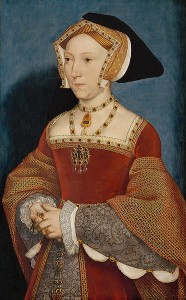 On this day in history, 12th October 1537, the eve of the feast of St Edward the Confessor, Queen Jane Seymour gave birth to a son who would grow up to be Edward VI. On this anniversary, I always receive questions about Edward’s birth so I thought I’d answer a few of the common ones in this post.
On this day in history, 12th October 1537, the eve of the feast of St Edward the Confessor, Queen Jane Seymour gave birth to a son who would grow up to be Edward VI. On this anniversary, I always receive questions about Edward’s birth so I thought I’d answer a few of the common ones in this post.
When did Jane Seymour take to her chamber?
Queen Jane Seymour took to her chamber at Hampton Court Palace, in preparation for the birth of her first child, on 16th September 1537.1 As I’ve said in my articles on Anne Boleyn taking to her chamber, a woman usually took to her chamber four to six weeks before her due date and for royal women it was preceded by a special church service. Jane must have thought that she was due to give birth between the 14th and 28th October.
How long was Jane Seymour’s labour?
The Spanish Chronicle records that Edward was born “after three days illness2 and Agnes Strickland quotes from a contemporary ballad which states that her labour lasted thirty hours:
The queen in travail, pained sore
Full thirty woeful hours and more;
And no ways could relieved be,
As all her ladies wished to see;
Wherefore the king made greater moan
Than ever yet his grace had done.3
The Register of the Most Noble Order of the Garter records that “Queen Jane was freed from her very hard Labour, which she had bore with exceeding Pain for about two whole days.”4
Edward VI was born at 2am on 12th October 1537 so it appears that Jane went into labour on 9th or 10th October. We know from Charles Wriothesley’s chronicle that there was a solemn procession in London to pray for Jane on 11th October.5
Did Jane Seymour have a c-section?
No! Click here to read a full article answering this question.
Why did Jane Seymour die?
Jane Seymour died on 24th October 1537, twelve days after giving birth to her son. It is thought that she died of puerperal fever, also known as childbed fever. Click here to read about her illness and death.
Notes and Sources
- “On Sunday next the Queen will take her chamber.” Letter from Sir William Fitzwilliam to Thomas Cromwell on Wednesday 12th September 1537, Letters and Papers, Foreign and Domestic, Henry VIII, Volume 12 Part 2, 680.
- transl. Hume, Martin A. Sharp, The Chronicle of King Henry VIII of England (The Spanish Chronicle), p.73.
- Strickland, Agnes (1850) Lives of the Queens of England: From the Norman Conquest; with Anecdotes of their Courts, Volume IV, Philadelphia: Lea and Blanchard, p226.
- The Register of the Most Noble Order of the Garter, From its Cover in Black Velvet, usually called The Black Book; with Notes… In Two Volumes (1724), London, printed by John Barber, p. 410.
- Wriothesley, Charles (1875) A chronicle of England during the reigns of the Tudors, from A.D. 1485 to 1559, Volume 1, Camden Society, p. 65-66.
